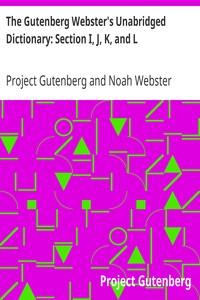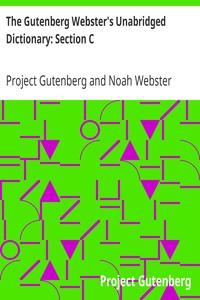Read this ebook for free! No credit card needed, absolutely nothing to pay.
Words: 321824 in 473 pages
This is an ebook sharing website. You can read the uploaded ebooks for free here. No credit cards needed, nothing to pay. If you want to own a digital copy of the ebook, or want to read offline with your favorite ebook-reader, then you can choose to buy and download the ebook.


: The Gutenberg Webster's Unabridged Dictionary: Section I J K and L by Project Gutenberg Webster Noah - English language Dictionaries
Begin file 5 of 11: I, J, K, and L. of An electronic field-marked version of:
This electronic version was prepared by MICRA, Inc. of Plainfield, NJ. Last edit February 11, 1999.
This version is only a first typing, and has numerous typographic errors, including errors in the field-marks. Assistance in bringing this dictionary to a more accurate and useful state will be greatly appreciated. This electronic dictionary is made available as a potential starting point for development of a modern on-line comprehensive encyclopedic dictionary, by the efforts of all individuals willing to help build a large and freely available knowledge base. Anyone willing to assist in any way in constructing such a knowledge base should contact:
Patrick Cassidy cassidy@micra.com 735 Belvidere Ave. Office: 668-5252 Plainfield, NJ 07062 561-3416
<! p. 723 !>
I . 1. I, the ninth letter of the English alphabet, takes its form from the Phoenician, through the Latin and the Greek. The Phoenician letter was probably of Egyptian origin. Its original value was nearly the same as that of the Italian I, or long e as in mete. Etymologically I is most closely related to e, y, j, g; as in dint, dent, beverage, L. bibere; E. kin, AS. cynn; E. thin, AS. ?ynne; E. dominion, donjon, dungeon. In English I has two principal vowel sounds: the long sound, as in pne, ce; and the short sound, as in pn. It has also three other sounds: That of e in term, as in thirst. That of e in mete , as in machine, pique, regime. That of consonant y , as in bunion, million, filial, Christian, etc. It enters into several digraphs, as in fail, field, seize, feign. friend; and with o often forms a proper diphtong, as in oil, join, coin.
See Guide to Pronunciation, ?? 98-106.
The dot which we place over the small or lower case i dates only from the 14th century. The sounds of I and J were originally represented by the same character, and even after the introduction of the form J into English dictionaries, words containing these letters were, till a comparatively recent time, classed together.
I- , prefix. See Y- .
I , pron. The nominative case of the pronoun of the first person; the word with which a speaker or writer denotes himself.
I"amb , n. An iambus or iambic.
The following couplet consists of iambic verses.
Free books android app tbrJar TBR JAR Read Free books online gutenberg
More posts by @FreeBooks

: The Gutenberg Webster's Unabridged Dictionary: Section C by Project Gutenberg Webster Noah - English language Dictionaries


: The Gutenberg Webster's Unabridged Dictionary: Section A and B by Project Gutenberg Webster Noah - English language Dictionaries






